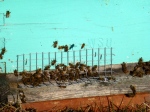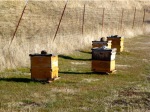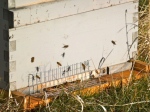Bees in January
What do honey bees do in January in eastern Washington? Why, they come out and fly around, of course! At least they might if the weather is as warm as its been on the Palouse Prairie and the campus of Washington State University through early winter. One day in early January, while stopping to take some pictures on campus, I was surprised to notice honey bees flying around the entrance to some beehives just off the corner of a parking lot. But January 4th, and bees?
I’m not a bee expert, but it didn’t take long to do some searching for bee information online and discover that honey bees will take advantage of warmer temperatures in winter (generally when above 50 F) to fly from the hive for a “cleansing flight” during which they eliminate body wastes and clean the hive of dead bees.
Ordinarily, the bees are clustered in a mass to conserve body heat and keep the queen warm in the center. But when temperatures warm enough, cleansing flights are made as a valuable part of colony maintenance, because bees don’t void bodily wastes inside the hive.
So the honey bees on campus were busy in early January, cleaning out their hives. In fact, I later discovered a honey bee flying around inside the greenhouse at the WSU Arboretum & Wildlife Conservation Center, even though the nearest known bee hives are about 300 – 400 m away from the arboretum greenhouse. And just in case you don’t believe me, here’s the photos to provide it.
.







Hi Rod – Despite the correction in MS Word Program – the accepted spelling of honey bee in the US and most parts of the world is honey bee (not honeybee). The rule (derived from the Entomological Society of America handbook on common names) could be paraphrased as…If the common name is “taxonomically correct”…then use two words. Thus, honey bee, bumble bee, house fly, blow fly etc. are written as two words because these critters are indeed bees and flies, respectively. Dragonfly, butterfly, etc. are written as one word because they ARE NOT flies. While the British and some of their former colonies tend to continue the older usage – the rule of “taxonomic correctness” is a useful one that lets the informed reader know whether the common name being used indicates the “type” of insect being described.
just thought you might want to know.
steve
Hi, Steve. Thanks for the heads up to a bee amateur. However, given that we’re considering starting up a citizen science project this year on pollinators, I suppose I’d at least better learn how to spell honey bee!